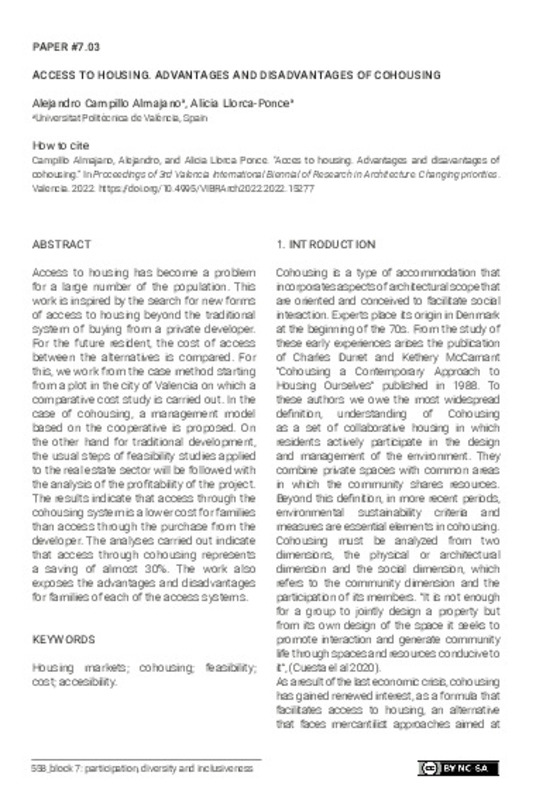JavaScript is disabled for your browser. Some features of this site may not work without it.
Buscar en RiuNet
Listar
Mi cuenta
Estadísticas
Ayuda RiuNet
Admin. UPV
Access to housing. Advantages and disadvantages of cohousing
Mostrar el registro sencillo del ítem
Ficheros en el ítem
| dc.contributor.author | Campillo Almajano, Alejandro
|
es_ES |
| dc.contributor.author | Llorca Ponce, Alicia
|
es_ES |
| dc.date.accessioned | 2023-12-19T08:39:57Z | |
| dc.date.available | 2023-12-19T08:39:57Z | |
| dc.date.issued | 2023-05-22 | |
| dc.identifier.isbn | 9788413960265 | |
| dc.identifier.uri | http://hdl.handle.net/10251/200897 | |
| dc.description.abstract | [EN] Access to housing has become a problem for a large number of the population. This work is inspired by the search for new forms of access to housing beyond the traditional system of buying from a private developer. For the future resident, the cost of access between the alternatives is compared. For this, we work from the case method starting from a plot in the city of Valencia on which a comparative cost study is carried out. In the case of cohousing, a management model based on the cooperative is proposed. On the other hand for traditional development, the usual steps of feasibility studies applied to the real estate sector will be followed with the analysis of the profitability of the project. The results indicate that access through the cohousing system is a lower cost for families than access through the purchase from the developer. The analyses carried out indicate that access through cohousing represents a saving of almost 30%. The work also exposes the advantages and disadvantages for families of each of the access systems. | es_ES |
| dc.format.extent | 9 | es_ES |
| dc.language | Inglés | es_ES |
| dc.publisher | Editorial Universitat Politècnica de València | es_ES |
| dc.relation.ispartof | Proceedings - 3rd Valencia International Biennial of Research in Architecture, VIBRArch | |
| dc.rights | Reconocimiento - No comercial - Compartir igual (by-nc-sa) | es_ES |
| dc.subject | Housing markets | es_ES |
| dc.subject | Cohousing | es_ES |
| dc.subject | Feasibility | es_ES |
| dc.subject | Cost | es_ES |
| dc.subject | Accesibility | es_ES |
| dc.title | Access to housing. Advantages and disadvantages of cohousing | es_ES |
| dc.type | Capítulo de libro | es_ES |
| dc.type | Comunicación en congreso | es_ES |
| dc.identifier.doi | 10.4995/VIBRArch2022.2022.15277 | |
| dc.rights.accessRights | Abierto | es_ES |
| dc.contributor.affiliation | Universitat Politècnica de València. Departamento de Organización de Empresas - Departament d'Organització d'Empreses | es_ES |
| dc.contributor.affiliation | Universitat Politècnica de València. Escuela Técnica Superior de Arquitectura - Escola Tècnica Superior d'Arquitectura | es_ES |
| dc.contributor.affiliation | Universitat Politècnica de València. Instituto Universitario de Restauración del Patrimonio - Institut Universitari de Restauració del Patrimoni | es_ES |
| dc.description.bibliographicCitation | Campillo Almajano, A.; Llorca Ponce, A. (2023). Access to housing. Advantages and disadvantages of cohousing. Editorial Universitat Politècnica de València. 558-566. https://doi.org/10.4995/VIBRArch2022.2022.15277 | es_ES |
| dc.description.accrualMethod | OCS | es_ES |
| dc.relation.conferencename | 3rd Valencia International Biennial of Research in Architecture, VIBRArch | es_ES |
| dc.relation.conferencedate | Noviembre 09-11, 2022 | es_ES |
| dc.relation.conferenceplace | Valencia, España | es_ES |
| dc.relation.publisherversion | http://ocs.editorial.upv.es/index.php/VIBRArch/VIBRArch2022/paper/view/15277 | es_ES |
| dc.description.upvformatpinicio | 558 | es_ES |
| dc.description.upvformatpfin | 566 | es_ES |
| dc.type.version | info:eu-repo/semantics/publishedVersion | es_ES |
| dc.relation.pasarela | OCS\15277 | es_ES |








